The Importance of the Jeweler's Hammer in Craftsmanship
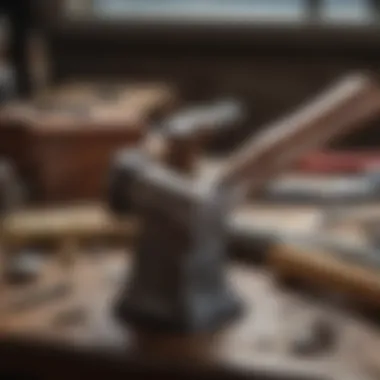
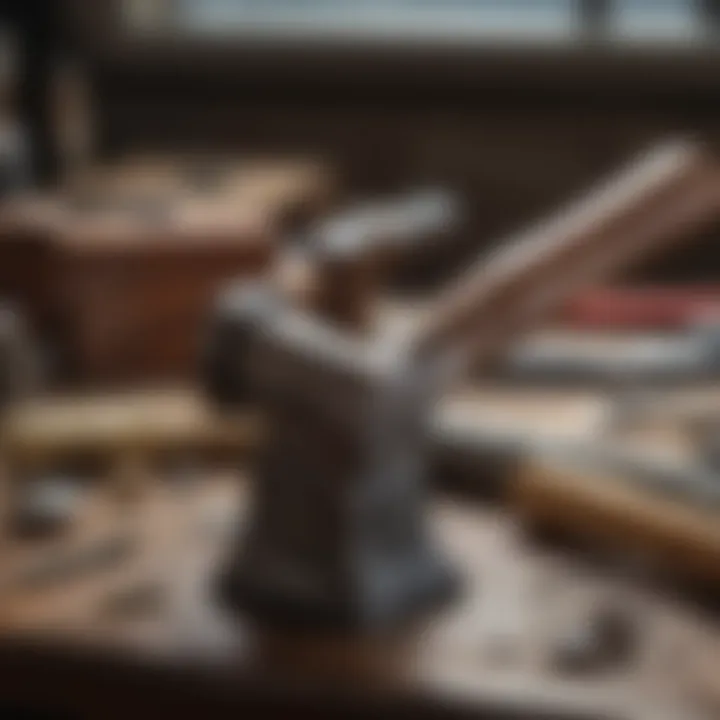
Intro
The jeweler's hammer resides at the core of jewelry making. Its design and versatility are critical to the art of creating stunning pieces, whether ornate rings or intricate necklaces. This article unpacks the importance of the jeweler's hammer, guiding artisan jewelry makers and enthusiasts alike in understanding its various forms and functions.
A jeweler's hammer is not just an ordinary hammer; it serves multiple purposes, from shaping metals to setting stones. The relationship between the tool and its user can greatly influence the end product. By acquiring knowledge about different types of hammers, the reader can refine their craft and elevate their jewelry designs.
As we wander through history and examine the tool's evolution, context emerges that deepens our appreciation for this essential instrument. This article also presents practical advice on choosing and maintaining a jeweler's hammer, equipping readers with the skills they need to ensure longevity and optimal performance. Let's explore the integral role the jeweler's hammer plays in craftsmanship.
Prelude to the Jewelers Hammer
The jewelers hammer plays a pivotal role in the intricate world of jewelry making. This often overlooked tool is fundamental in defining the craftsmanship and quality of pieces that artisans create. Understanding its importance sheds light on the precision and skill required by jewelers in their craft.
Defining the Jewelers Hammer
The jewelers hammer is a specialized tool designed for the unique demands of jewelry making. Unlike ordinary hammers, it is specifically shaped and weighted to facilitate delicate tasks such as shaping, joining, and texturing metal. The head of a jewelers hammer can vary in form, catering to different techniques and applications. From the flat surface for gentle tapping to the ball peen end for creating rounded impressions, each design serves a particular purpose. This diversity is essential for jewelers who work with various metals and styles.
The Role of Tools in Jewelry Making
Tools are the cornerstone of jewelry making, and the jewelers hammer stands out as one of the most crucial among them. Each tool aids specific tasks, and using the right one can significantly affect the end result. A jeweler's skill is often a reflection of their tools.
- Precision: The right tool, such as the jewelers hammer, allows for precise manipulation of metal, ensuring finely crafted designs.
- Efficiency: Using appropriate instruments expedites the process while enhancing quality, which is vital in a competitive market.
- Techniques: Familiarity with tools leads to mastery in techniques, allowing jewelers to innovate and refine their craft.
In summary, hammers and other tools form the backbone of jewelry making, influencing the quality and artistry of creations. Recognizing their importance fosters a deeper appreciation for the craftsmanship behind beautiful jewelry.
Types of Jewelers Hammers
Understanding the various types of jewelers hammers is crucial for both novice and experienced craftsmen. Each hammer serves distinct purposes and affects the quality of work in different ways. Knowing which hammer to use can determine the precision and efficacy in shaping and joining metals. Jewelers hammers are not all the same; they come in various forms, each tailored for specific tasks.
Ball Peen Hammer
The ball peen hammer is perhaps one of the most recognized types of hammers used in jewelry making. This tool features a flat surface on one side and a rounded peen on the opposite side. Its design makes it versatile, allowing jewelers to shape metal effectively. The flat side is ideal for flattening metal sheets, while the ball end can create round shapes or indentations.
It's practical for cold working processes where no heat is applied. Using a ball peen hammer can enhance the fine details of a piece, making it easier to form and refine intricate designs.
Ring Hammer
Designed specifically for forming rings, this hammer features a unique shape that assists in the curvature process. The smooth, rounded face allows for even distribution of force, reducing the risk of dents and imperfections in the metal. Jewelers appreciate the ring hammer for its ability to create uniform shapes and sizes. It also facilitates precision work, essential when fabricating rings from thick materials. The thoughtful design helps avoid excessive stretching while maintaining the integrity of the metal.
Cross Peen Hammer
The cross peen hammer is distinctive due to its flat striking face and a tapered end oriented perpendicular to the handle. This tool is favored for metalworking tasks requiring more concentrated force. Jewelers often use it for stretching and thinning metals. When you require a hammered texture, the cross peen can deliver this through its specialized shape. This hammer enhances control over the material, allowing for detailed work and adjustment in jewelry designs.
Rubber Hammer
Unlike its metal counterparts, the rubber hammer is essential for tasks that require a softer touch. This tool is particularly useful when working with delicate materials or when minimizing the risk of scratching or damaging the surface. Jewelers use rubber hammers predominantly in assembling components without marring the finish. It is especially handy during the joining process, where gentle pressure is required. This hammer allows for precise adjustments while ensuring the integrity of the pieces involved.
Each type of jeweler's hammer contributes unique advantages to the craft. By selecting the right hammer for specific tasks, artisans can improve their skill and produce high-quality jewelry. Understanding these tools is fundamental for anyone passionate about jewelry design.
Functions of the Jewelers Hammer
The jeweler's hammer serves multiple critical functions, making it an indispensable tool in the world of jewelry making. Understanding these functions can help artisans improve their craft, ensuring precision and enhancing the quality of their work. Each function focuses on a distinct aspect of jewelry design and repair, highlighting the value of this simple yet powerful tool.
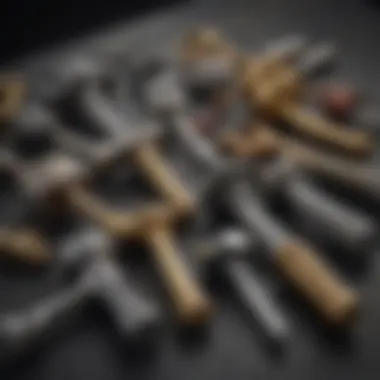
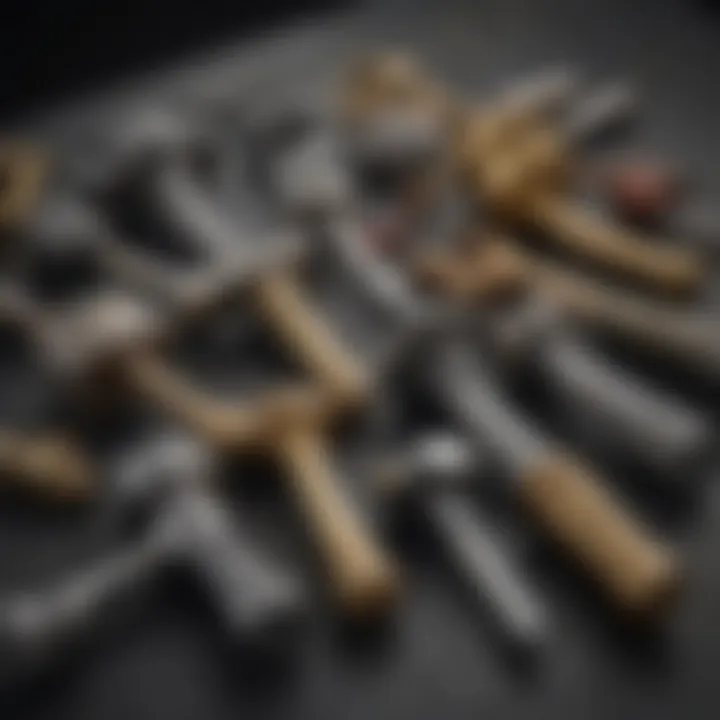
Shaping Metal
Shaping metal is one of the primary functions of the jeweler's hammer. The process involves deforming metal to achieve the desired form. Jewelers utilize various types of hammers, such as the ball peen hammer or the ring hammer, to manipulate metal sheets or wires effectively. The controlled strikes allow for intricate designs, including curves and angles. The jeweler's hammer aids in the transformation of raw material into artistic pieces, which are both visually appealing and structurally sound.
Joining Materials
Another essential function of the jeweler's hammer is joining materials. In jewelry making, pieces often need to be connected securely. Jewelers may rely on a hammer to set stones and join different components together. This process may involve soldering and requires precise strikes. The chosen hammer can influence the quality of the joint, making it essential to select the correct type for the task. Proper joining enhances not just the aesthetics, but also the longevity of the jewelry.
Creating Texture
Creating texture refers to the process of adding detail to a metal surface. Jewelers use hammers to create patterns, indentations, or imprints. This is often done with specialty hammers, which feature textured faces. The ability to create unique textures allows jewelers to distinguish their works and provides originality to each piece. Textured surfaces can enhance light reflections, adding depth and complexity, which captures the eye of potential buyers or admirers.
Repairing Jewelry
Repairing jewelry is a significant function of the jeweler's hammer. Over time, pieces may become damaged or worn. Jewelers use hammers to reshape bent components or to tighten loose settings. This can involve light taps to avoid further damage to the delicate materials. Understanding how to effectively use a hammer in repair work is critical for preserving the integrity of the jewelry. It minimizes the risk of compromising the design while ensuring the piece remains functional and aesthetically pleasing.
As you explore each of these functions further, it becomes clear that the jeweler's hammer is much more than a tool; it is an instrument of creativity and craftsmanship.
Choosing the Right Hammer
Selecting the correct jeweler's hammer is not just about preference; it has a significant impact on the quality and precision of your work. The right hammer helps you execute your tasks efficiently, be it shaping, joining, or repairing materials. An informed choice will enhance your craftsmanship and can ultimately determine the success of a project.
Assessing Material Needs
To choose the proper hammer, it is crucial to consider the materials you will be working with. Different metals and materials respond uniquely to hammering. For instance, softer metals like gold or silver may require lighter hammers to avoid deformation. In contrast, harder metals like tungsten need more robust hammers to drive the necessary force without risking damage to the tool itself.
Evaluating the hardness and thickness of the material can help in making the right decision. It may also be beneficial to look at the type of project. Thin sheets of metal may require precision hammers like the ball peen hammer, while larger pieces might benefit from a heavier cross peen hammer.
Understanding Weight and Balance
The weight of a hammer plays a vital role in its functionality. A well-balanced hammer allows for better control and accuracy during use. Each craftsperson develops their preference based on comfort and workflow, so experimenting with different weights could be enlightening.
A lighter hammer can lead to fatigue when used for extended periods, while a heavier hammer can make precise adjustments harder. Finding a balance between the two is essential. Beaware of how the hammer feels when you hold it.
Evaluating Handle Length and Grip
The handle length and grip design are also crucial in the selection process. Handles that are too short can limit leverage, making it harder to apply the desired force. Conversely, overly long handles may become cumbersome and affect your dexterity.
A proper grip can prevent slippage and ensure that you can exert maximum control over the hammer. Look for hammers with ergonomic handles, as these can provide comfort and reduce strain during prolonged use. Testing different grips in practice can illuminate which feels most natural.
Tips: When purchasing a hammer, try holding it and mimic striking an object to assess comfort and control.
Overall, the careful evaluation of your needs concerning materials, weight, and grip type enhances your choice, enabling you to achieve high-quality results in your jewelry making.
Techniques for Using a Jewelers Hammer
Understanding the various techniques for using a jeweler's hammer is essential for both beginners and seasoned professionals. Mastering these techniques enhances the quality of work and can improve efficiency. Moreover, appropriate techniques minimize the risk of errors or damage to valuable materials during the crafting process.
Basic Hammering Techniques

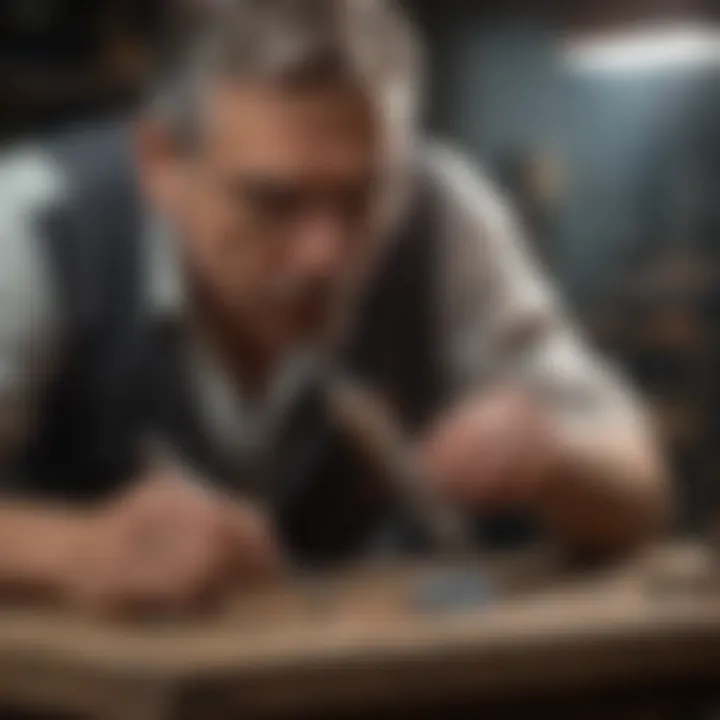
Basic hammering techniques lay the foundation of jewelry making. Learning how to properly grip the hammer is crucial. Holding it too tightly can lead to muscle fatigue, while a loose grip may cause poor control. Aim for a firm, yet relaxed grip that allows for precise movements.
When you strike the metal, focus on the angle of contact. A direct strike can bend or distort the material, while a glancing blow can produce a clean edge. It is also important to be consistent with the force applied. Beginners should practice striking on a softer metal first. This helps in understanding the required pressure and angle without damaging more precious materials.
In summary, some of the basic hammering techniques include:
- Maintaining a proper grip.
- Controlling strike angle and force.
- Practicing on softer materials to build skills.
Advanced Hammering Techniques
Advanced hammering techniques involve intricate skills that elevate the craftsmanship. These techniques are essential when working on detailed designs or fine textures. One technique is the use of different parts of the hammer's head to achieve varied effects. For example, using the rounded side can create finer lines or shapes, while the flat side is ideal for flattening materials.
Moreover, understanding how to manipulate the hammer speed can greatly affect the result. Fast strikes may harden the material quickly, resulting in reduced malleability for further shaping. Slower, controlled strikes often allow for better precision and control, especially when attempting to create delicate features.
Practicing these techniques with attention to detail can significantly enhance the quality of your work:
- Utilizing specific parts of the hammer for targeted effects.
- Controlling the speed of the strikes for desired results.
- Adapting techniques based on material being worked on.
Safety Precautions
Safety should be a priority when using a jeweler's hammer. Many accidents in the workshop can be prevented with proper precautions. For starters, wearing appropriate safety gear is necessary. Safety goggles protect eyes from flying debris, while gloves shield hands from accidental strikes.
Additionally, it is essential to maintain a clean workspace. Clutter can lead to injuries or accidents. Ensure tools are in good condition, as a damaged hammer can lead to an unexpected malfunction. Regular inspection of equipment helps prevent risks during work.
Lastly, be mindful of your posture while working. Standing or sitting awkwardly can cause long-term injuries. Take breaks to stretch and rest muscles. Following these safety precautions can foster a secure environment for productive work:
- Always wear safety goggles and gloves.
- Keep the workspace tidy and organized.
- Regularly inspect tools for wear or damage.
- Maintain proper posture and take frequent breaks.
Historical Perspective of the Jewelers Hammer
The jewelers hammer, a cornerstone tool in the crafting of jewelry, has a rich historical background that showcases its evolution and significance. Understanding this history is essential to appreciating not just the tool itself but the art of jewelry making as a whole. The jeweler’s hammer has served various purposes throughout the ages, from formative techniques to modern methods. Notably, its design and functionality reflect the traditions and innovations that have occurred in the craftsmanship of jewelry.
Origins and Evolution
The origins of the jewelers hammer can be traced back to ancient civilizations. Archaeological evidence indicates that primitive hammering tools were utilized as far back as the Egyptain and Mesopotamian societies, where artisans worked with metals and precious stones. Initially, these hammers were simple objects, often made of stone or wood.
As time progressed, the jeweler’s hammer adapted to the changing needs of artisans. The introduction of metalworking techniques led to hammers being forged from materials such as bronze and iron. This shift not only improved durability but allowed for greater precision in manipulating delicate metals. The versatility of the hammer expanded as craftsmen developed specialized types, leading to the numerous varieties seen today.
These changes influenced both the aesthetics and practicality of jewelry, contributing to more intricate designs. The development of the jewelers hammer parallels broader advancements in metallurgy and craftsmanship, demonstrating how tool innovation can enhance artistic expression.
Cultural Significance in Different Regions
The cultural impact of the jeweler’s hammer varies across regions, influenced by local traditions, available materials, and artistic values. In Europe, hammering techniques were central to the Renaissance, as artists and jewelers sought to revive classical styles. The use of the hammer in this context symbolizes a return to craftsmanship, where each piece is meticulously shaped and polished.
In Asia, particularly in countries like India and Japan, the hammer carries a spiritual aspect in addition to its functional role. For instance, Indian artisans incorporate rituals into their crafting process, whereby the hammering of metals is seen as a form of meditation. This practice not only produces beautiful jewelry but also strengthens the craftsman's connection to their cultural heritage.
On the other hand, in parts of Africa, hammers are used in collaborative community efforts. Techniques are passed down through generations, with hammers becoming tools of social continuity. Artisans may gather to share skills and create pieces that reflect both individual artistry and collective tradition.
"The hammer is not merely an implement; it is a bridge between past traditions and contemporary practices in jewelry making."


Caring for Your Jewelers Hammer
Caring for your jeweler's hammer is not just a matter of keeping tools clean. It involves a commitment to maintaining quality, ensuring longevity, and enhancing functionality. Proper care can significantly impact your craftsmanship. A well-maintained hammer allows for precise strikes, which helps in achieving desired shapes and finishes on metal. Neglecting this essential tool can lead to performance issues, such as uneven striking or even damage to your creations. Therefore, investing time in the care of your hammer is ultimately an investment in the quality of your work.
Regular Maintenance
Maintaining your jeweler's hammer involves several key practices. First, it is vital to clean the hammer after each use. Residue from metal, dirt, or any lubricants can accumulate on the head and handle. Use a soft cloth for cleaning, and for stubborn substances, a gentle scrub can work. Be sure to dry the hammer well to prevent rust formation.
Secondly, periodically inspect your hammer for damage. Look for dents or cracks in the hammerhead and any wear on the handle. If noticed, the hammer may need repair or replacement. Moreover, consider applying a light coat of oil to the metal parts if the hammer is steel. This prevents rust and maintains the surface integrity.
Lastly, keeping the hammer stored properly is also a part of maintenance. Avoid leaving it exposed to elements that can cause corrosion. Regular maintenance ultimately extends the lifespan of your jeweler's hammer and keeps it performing at optimal levels.
Storing Techniques
The way you store your jeweler's hammer can affect its condition over time. Ideally, the hammer should be kept in a dry environment. Moisture can lead to rusting, especially for steel hammers. Utilize a toolbox or a dedicated storage space where the hammer can be laid down without hitting other tools, which can create accidental damage.
Consider using magnetic strips or tool organizers to keep hammers easily accessible yet protected. If using a hammer rack, ensure it has padding or some form of cushioning to avoid wear on the hammer's surface.
When not in use for extended periods, wrapping the hammer in a soft cloth can provide additional protection against dust and scratches. Proper storing techniques ensure that your jeweler's hammer serves you well for years to come.
The Impact of Quality on Craftsmanship
Quality tools are integral to the craft of jewelry making. The jeweler's hammer, in particular, serves as a prime example where quality directly affects the outcomes in craftsmanship. The impact of quality is not merely a matter of aesthetics; it encompasses precision, durability, and overall craftsmanship. When one invests in a quality jeweler's hammer, the benefits manifest throughout the entire jewelry-making process.
A good hammer allows for superior handling while working with various materials. High-quality hammers provide better balance and weight distribution. This ensures that artisans can exert the right amount of force needed without undue fatigue. Moreover, quality tools can yield consistent results. Repeatability in craftsmanship is essential because it contributes to overall design integrity and reliability in a finished piece.
In contrast, low-quality hammers can lead to improper shaping and joining, negatively affecting both the appearance and durability of the jewelry. Delicate designs can become bruised or misshapen if the tool's head is not properly crafted. Therefore, the impact of quality on craftsmanship cannot be overstated.
Significance of Using Quality Tools
Using top-quality tools is crucial for several reasons in jewelry making. First, quality tools like the jeweler's hammer improve precision. With a well-made hammer, the artisan can create fine details and precise angles, which is essential for high-end designs. A precise tool also reduces the chances of damaging the material being worked on.
Next, durability is another factor. Quality hammers resist wear and tear better than their cheaper counterparts. This means they stay effective longer and require less frequent replacement. The long-term cost-effectiveness of using high-quality tools often outweighs their initial investment.
"Quality is not an act, it is a habit." – Aristotle
Economic Considerations
While it may seem easy to opt for lower-priced options, choosing quality tools like a jeweler's hammer can have far-reaching economic benefits. Initially, high-quality hammers may come with a higher price tag, but this purchase can lead to significant savings over time. Fewer replacements, paired with better craftsmanship, often translate into higher profit margins for jewelry makers.
Moreover, producing superior jewelry can lead to enhanced customer satisfaction. Happy customers are more likely to make repeat purchases and refer others. Therefore, while the upfront costs may be higher, the long-term benefits include not just savings but also revenue growth.
Culmination
In this article, we covered the importance of the jewelers hammer within the realm of jewelry making. The jewelers hammer is not just a simple tool; it is an essential instrument that defines the craft. Understanding its different types, functions, and techniques is crucial for any artisan looking to enhance their skills. The craftsmanship quality directly relates to the tools used, and the jewelers hammer stands out as a key player.
Summary of Key Points
- Defining the Tool: We started by defining the jewelers hammer, discussing its historical significance and role in jewelry making.
- Types of Hammers: Different types of jewelers hammers, such as the ball peen hammer and the rubber hammer, each serve unique purposes. Knowing which one to use in certain situations can greatly affect the outcome of the work.
- Functions: We explored how jewelers use the hammer for shaping, joining materials, and creating textures in their designs. Each function is crucial for producing high-quality jewelry.
- Techniques for Use: Understanding the basic and advanced techniques for using a jewelers hammer helps in achieving the desired results while minimizing damage to materials.
- Caring for the Tool: Regular maintenance and proper storage of the hammer can prolong its life and maintain its effectiveness, which is often overlooked.
Future Perspectives on Tool Use in Jewelry Making
Looking ahead, the realm of jewelry making is likely to see innovations in tools and techniques as technology progresses. Digital tools may complement traditional methods, offering enhanced precision and ease. However, the jewelers hammer will likely remain a staple due to its simplicity and effectiveness. As artisans continue to blend traditional craftsmanship with modern technologies, the balance between tool use and creativity will be essential. Understanding how to effectively use and care for tools will elevate craftsmanship, ensuring the art of jewelry making continues to thrive.
As we reflect on the evolution of tools in craftsmanship, the jewelers hammer serves as a reminder of the blend between skill and equipment. Embracing both contemporary advancements and time-honored techniques will shape the future of jewelry design.



